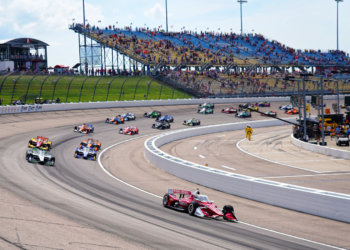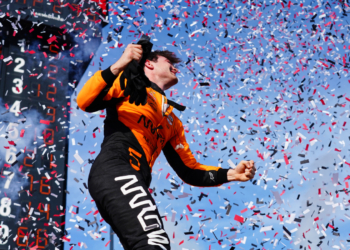The second test of the 2018 pre-season saw MotoGP break new ground with its first visit to the Buriram International Circuit in Thailand, in preparation for country's first ever Grand Prix in October.
The test offered the riders and teams a chance to assess the new circuit and put ideas together for potential set-up solutions, while it gave Michelin the opportunity to see how its rubber would react to the track.
On top of that, it was a chance for the teams to confirm the progress they had made at the first test in Malaysia last month, though for some it seemed more to be an exercise in hitting their heads against a brick wall.
'I don't know… I just don't know'
The most perplexed team leaving Thailand was undoubtedly Yamaha. The 2018 YZR-M1, with its new engine, new chassis and electronics improvements, seemed to be exactly the tonic for what plagued Valentino Rossi and Maverick Vinales last season. Both riders topped the Monday timesheets at Sepang, and were upbeat (or so it seemed) over the bike's pace despite a mystifying dip in form on the final day.

However, '17's issues struck back with a vengeance in Thailand. Rossi found the bike to still be suffering under acceleration, blaming the electronics. The Italian admitted Yamaha has struggled to adapt to the control software introduced in 2016 but, more worryingly, he also didn't see an end in sight for this issue.
“We know we have to work mostly on electronics, but I don't think there will be anything new on that in the next test in Qatar,” he said on Sunday after finishing the test tenth and 0.730 second off the pace. “This is something that could take several months [to fix]; until then, we are relying on fate.”
The Italian also said fixing big issues was harder, because a bike is so sensitive now, its performance changes from hour-to-hour let alone day-to-day. “Not optimistic” for the opening races at present, his team-mate Maverick Vinales gives off the impression he is not optimistic at all for the coming season after declaring the Thailand test his “worst” ever as a Yamaha rider.
The Spaniard also suffered with the electronics, though his issue was a lack of edge grip and traction through the corners. This completely threw off the bike's balance, with Vinales at a complete loss as to why. He even tried the '16 chassis – the same frame Tech3's Johann Zarco is using – but that still proved a dead end.
“By a long way this is the worst test. Even Sepang, that was the worst one since I've been at Yamaha, then today it's even worse,” said Vinales, who was ninth on the combined times at Buriram. “I don't know, honestly, I don't know. We are struggling as a factory team, so I don't know. I don't know what to say. It's difficult, we are missing a little bit in all areas. I've used different chassis, different engines, different electronics, but there is no solution, so I don't know. Honestly, I don't know.”
To make matters that more baffling, Zarco was just 0.086s off of the best lap of the test in second overall. That is on an M1 with the '16 chassis and '18 engine (albeit, slightly turned down) – that's essentially the same bike as the factory, as its new frame is based on the one Zarco is using to excellent effect.
Of course, as a customer rider his testing schedule is pretty much exclusively to focus on set-up. So, with a chassis familiar to him and with a season of experience behind him, Zarco is able to get up to speed much quicker than Rossi or Vinales. But with just three more days of testing left before the start of the season, it's all stations panic at Iwata.
Ducati's Mixed Fortunes
Ducati's Thailand test was similarly odd. After setting an unofficial lap record at Sepang and praising the GP18 as a bike “more suited to my riding style”, Jorge Lorenzo looked like he was going up a hill backwards at Buriram.

16th on the combined timesheets, ending the last day 22nd, the Spaniard just could not get on with the GP18, so much so that he even reverted to the GP17 – pinching it from Danilo Petrucci's garage – to assess just where the new bike is suffering.
“In Sepang I felt much better and on the last day I made the laptime,” he said. “But during these three days I didn't feel very comfortable and today I didn't work to make the laptime, so we cannot look at the position because I made the laptime when I made a [race] simulation. There was no point to go full time attack because there was no meaning.”
Lorenzo doesn't look likely to stick with the GP17, as the new bike has “more potential”. But he is hoping Ducati can “mix” the '17 with the '18, especially with a view to giving him more feeling with the front tyre.
Team-mate Andrea Dovizioso was low-key again, not putting in a representative flying lap because he kept making errors on his efforts. Focusing on a new chassis, as well as three new aerodynamic fairings, all seemed well within the 2017 runner-up's camp. Typically cautious in his assessment, Dovizioso has good reason to head to Qatar feeling confident.
Distant Early Warning
As, in fact, do Honda. Rather surprisingly, given how the RC213V has behaved over the last few years, Honda has had the most consistent bike across both tests so far. Of the six days of running, four have been topped by Honda ridres, with all three days of the Thailand test headed by either a Repsol rider or LCR's Cal Crutchlow.
Even Takaaki Nakagami impressed on his year-old RCV, the Japanese rider top rookie and just 0.675s from Pedrosa's test best lap on combined times. He even copped praise from team-mate Crutchlow, who highlighted the former Moto2 race winner's cornering speed as extremely impressive.

As was hinted at Sepang, all three riders seemed to have settled on HRC's latest engine for this season, while a new aero package and a carbon fibre swingarm – which was debuted at Valencia last year – were worked on.
Marquez, just as we did in Malaysia, did however offer up caution: “Here and Malaysia, it was working well. But I repeat; engine character is something we need to improve. We can't forget that we're in a very warm circuit. Okay, Qatar is warm but at night it's quite cold. We will see there how is the character of the engine, because in some areas it's too aggressive.”
Regardless, it isn't going unnoticed that all three factory Honda riders have been strong throughout testing, and as is the way with such a covert sport, it's impossible to tell just how accurate Marquez's assessments about the engine are.
Power and the Glory
One team that isn't hiding anything is Suzuki. The Hamamatsu factory is flying high again, with the Thailand test confirming the GSX-RR's improvement in engine, while a new chassis seems to be giving Alex Rins and Andrea Iannone a strong machine in the bends. “100 times better” was Rins' round-up of the bike after finishing the test four tenths off the pace in fifth overall.
He did admit he could do with a bit more power, but a new aero fairing is allowing Suzuki to dial out some electronic interference which will help in this area. And with no restriction on in-season engine development for the Japanese marque, there's no need to panic should the motor still be lacking a bit of thrust in Qatar.
Power is something Aprilia need. After finding the new engine wasn't what it should have been in Malaysia, the Noale factory has gone back to the drawing board. An answer should come for the Qatar, though not until the race. The chassis is at least still proving to be brilliant for Aleix Espargaro, while Scott Redding grows more confident as he accumulates more miles on the RS-GP; though he admits he needs to find more in the braking phase.
At KTM, Bradley Smith felt much better on the RC16 thanks to chassis upgrades in Thailand. But chatter on the front is robbing the Briton of confidence coming into the corners. Luckily, with suspension makers WP owned by KTM, total focus can be placed on a fix. How much the absence of the injured Pol Espargaro, who has proven to be a real development force for KTM, has affected the team's performance trajectory heading to Qatar remains to be seen.






